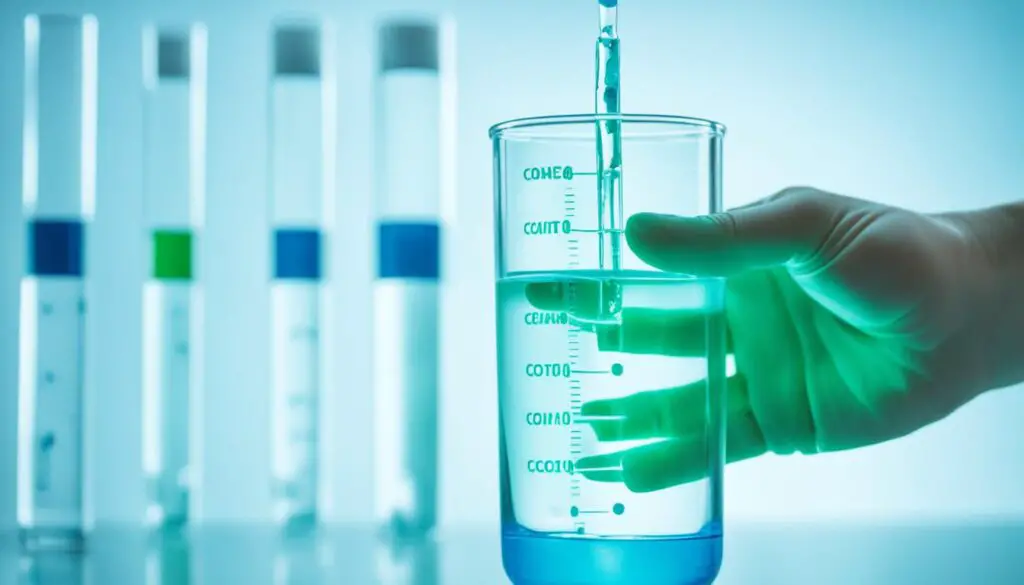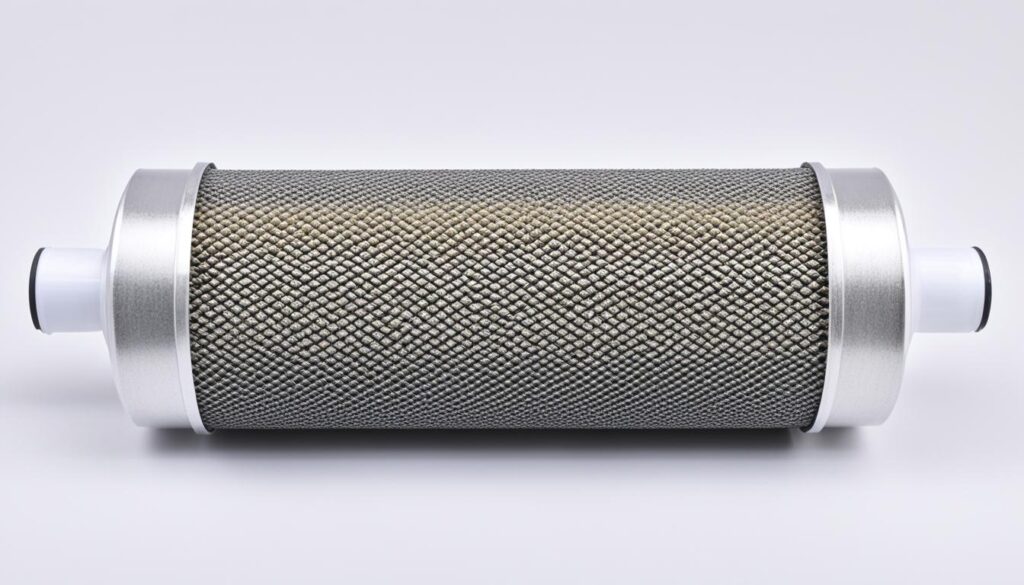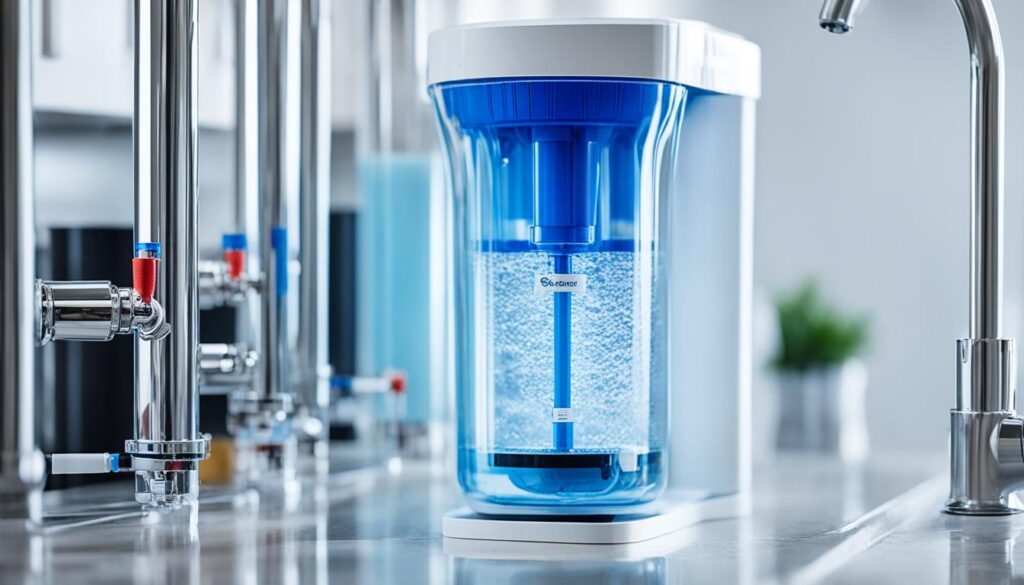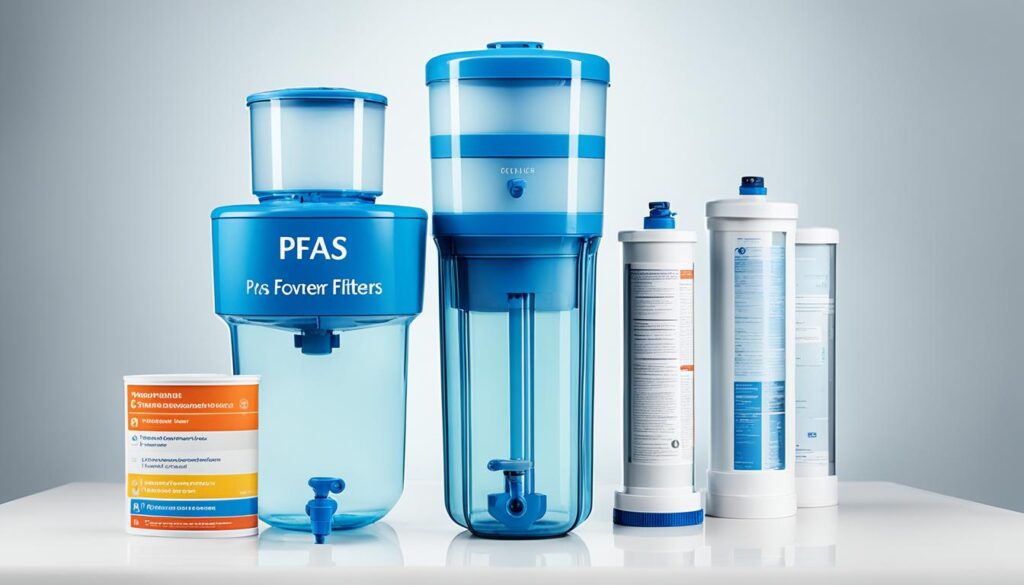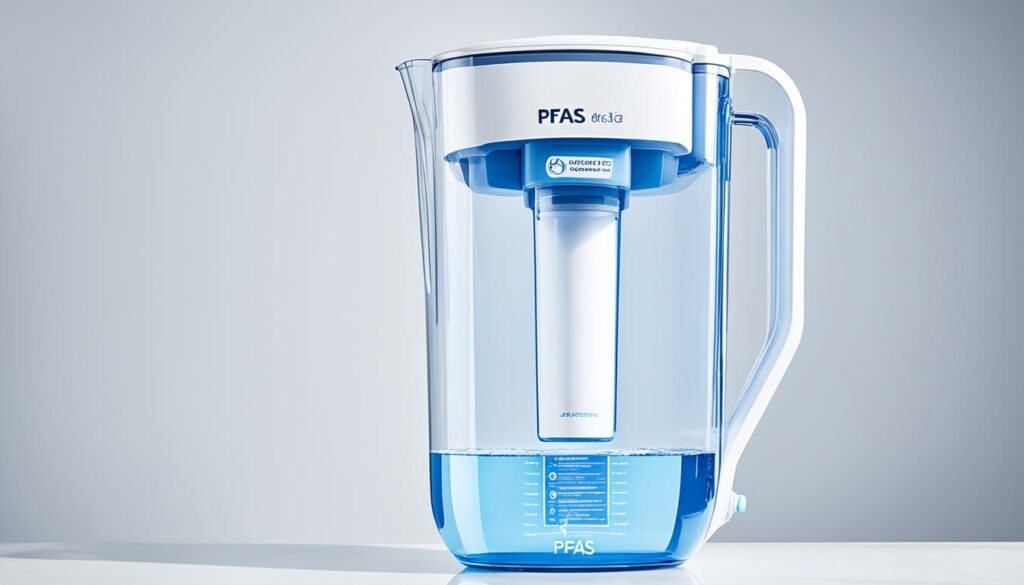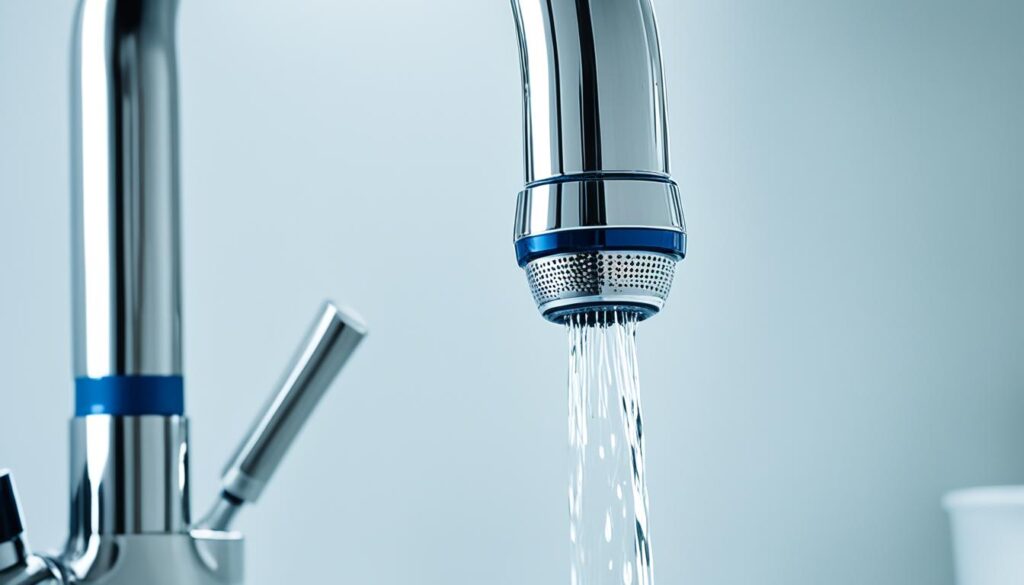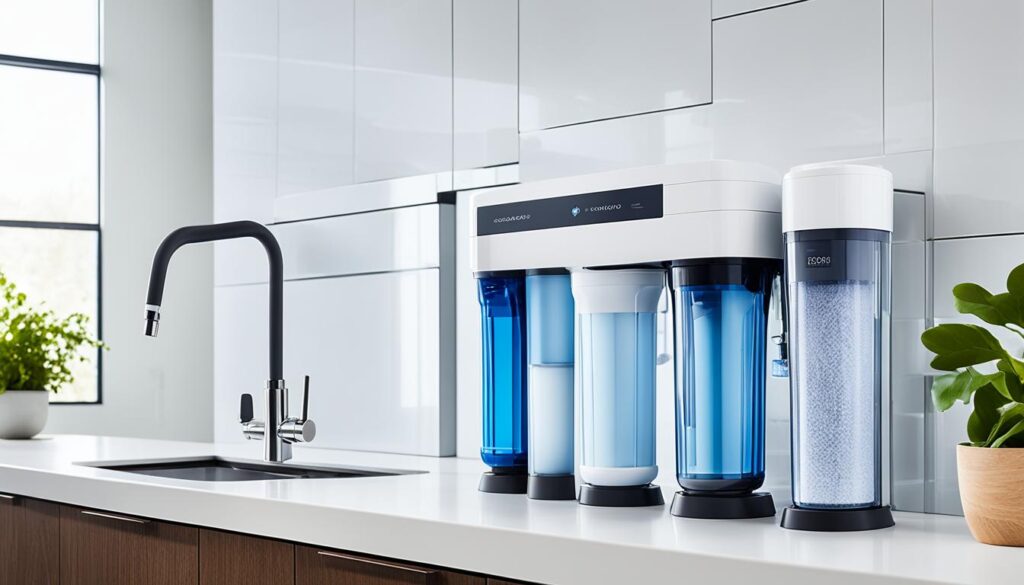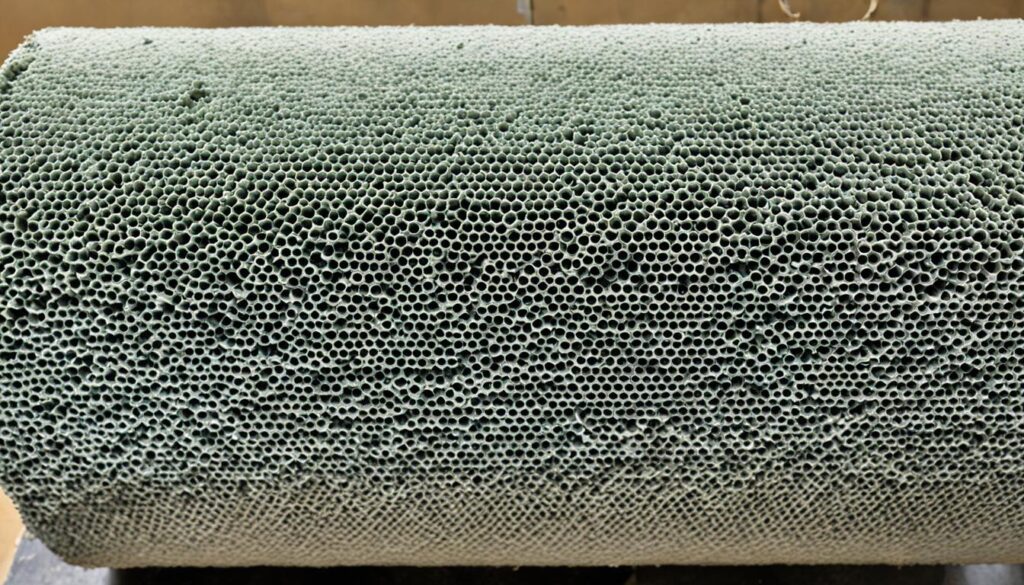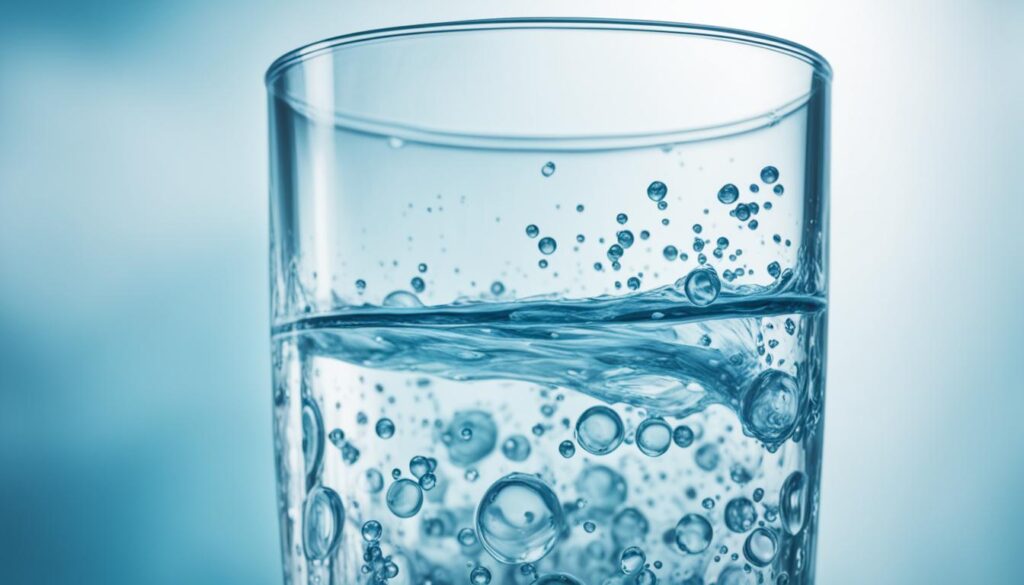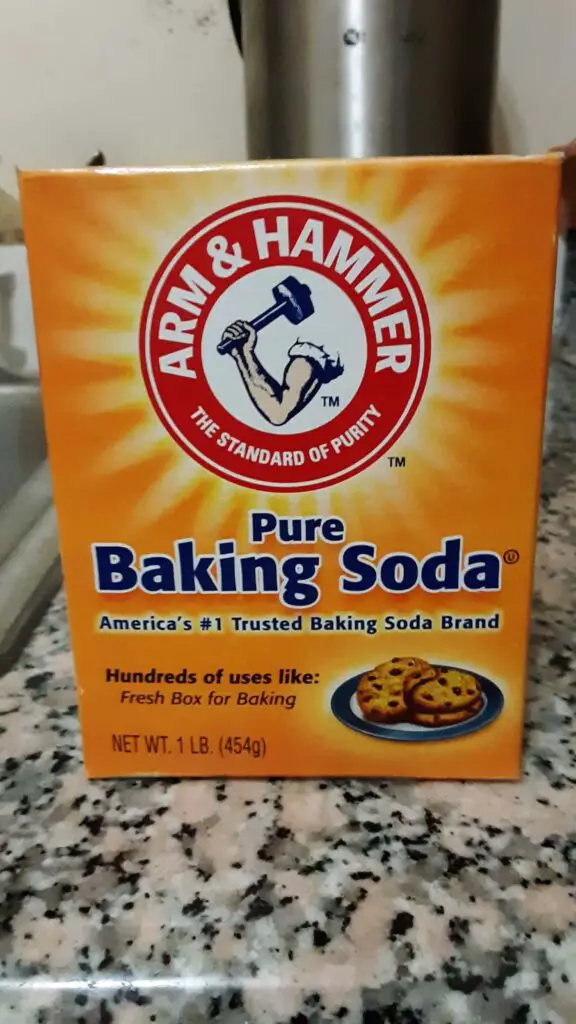Did you know that PFAS contaminate the drinking water of more than 3,000 communities, affecting an estimated 200 million Americans? That’s nearly two-thirds of the U.S. population potentially exposed to these “forever chemicals” through their tap water. As I examine this pressing issue, I’ll guide you through understanding PFAS and looking at effective ways to safeguard your drinking water safety.
PFAS, or per- and polyfluoroalkyl substances, are a group of man-made chemicals that have been used in various industries for decades. Their persistence in the environment and potential health risks have raised significant concerns. In this guide, I’ll share insights on water filtration methods to remove PFAS and help ensure the safety of your drinking water.
With almost half of all tap water in the U.S. containing PFAS, it’s crucial to understand your options for protection. From simple pitcher filters to advanced reverse osmosis systems, I’ll break down the effectiveness and costs of different filtration methods. Now I will discuss how you can take control of your water quality and minimize your exposure to these persistent pollutants.
Key Takeaways
- PFAS contamination affects an estimated 200 million Americans
- Almost half of U.S. tap water contains PFAS chemicals
- Effective home filtration options range from pitcher filters to reverse osmosis systems
- Some water filters can reduce PFAS by up to 100%
- Regular filter maintenance is crucial for optimal PFAS removal
- Whole-house filtration systems offer comprehensive protection but at a higher cost
- The EPA has proposed new limits for six PFAS in public water systems
Table of Contents
- 1 Understanding PFAS: The Forever Chemicals in Our Water
- 2 The Prevalence of PFAS in U.S. Drinking Water
- 3 How to Test Your Water for PFAS Contamination
- 4 Granular Activated Carbon (GAC) Filtration Systems
- 5 Reverse Osmosis (RO) Filtration: The Gold Standard for PFAS Removal
- 6 Ion Exchange Resins
- 7 Comparing Different Types of Water Filters for PFAS Removal
- 8 Pitcher filters: An affordable starting point
- 9 Faucet-mounted and under-sink options
- 10 Whole-house filtration systems for comprehensive protection
- 11 Top-Performing Water Filters for PFAS Reduction
- 12 The Importance of Regular Filter Maintenance and Replacement
- 13 Limitations of Home Filtration: What Filters Can’t Do
- 14 The Role of Government Regulations in PFAS Management
- 15 Beyond Filtration: Long-Term Solutions for PFAS Contamination
- 16 Environmental Impact of PFAS and the Need for Source Reduction
- 17 Staying Informed: Resources for PFAS Education and Water Quality Updates
Understanding PFAS: The Forever Chemicals in Our Water
PFAS, or per- and polyfluoroalkyl substances, are synthetic chemicals causing significant concern in our water. Known as “forever chemicals,” they resist breakdown in both the environment and human bodies. This nickname stems from their enduring presence.
What are PFAS and why are they called “forever chemicals”?
These man-made compounds are used for their water and stain resistance in various products. Their chemical bonds are incredibly strong, ensuring they last for years. This longevity has led to the term “forever chemicals.” PFOA and PFOS are prominent PFAS, phased out in the U.S., yet still present in our ecosystems. By 2022, eight states had laws requiring PFAS monitoring in public water systems.
Common sources of PFAS contamination
Various sources introduce PFAS into our water, causing widespread contamination. Key contributors include:
- Nonstick cookware
- Water-resistant clothing and fabrics
- Food packaging
- Firefighting foam
- Industrial waste
Health risks associated with PFAS exposure
Exposure to PFAS poses serious health risks. Research links these chemicals to several health problems:
| Health Concern | Potential Impact |
|---|---|
| Immune System | Suppression of immune response |
| Development | Delays in growth and learning |
| Cancer Risk | Increased risk of certain cancers |
| Metabolism | Changes in metabolic function |
| Reproduction | Fertility issues and pregnancy complications |
The Prevalence of PFAS in U.S. Drinking Water
PFAS, or “forever chemicals,” have contaminated nearly half of our tap water. This issue impacts both public water systems and private wells nationwide.
The Environmental Protection Agency (EPA) has taken action. They propose a new rule to limit six forms of PFAS in drinking water to just four parts per trillion. This could enhance water quality for up to 100 million Americans.
| Water Source | PFAS Contamination | Population Affected |
|---|---|---|
| Public Water Systems | 83-105 million people | 25-32% of U.S. population |
| Private Wells | Data limited | Estimated millions |
| Bottled Water | Several brands | Unknown |
The situation is grave. Exposure to PFAS has been linked to kidney and testicular cancer, high cholesterol, and hormone disruption. Shockingly, the CDC found PFAS in 99% of Americans’ blood, including newborns.
While the EPA works on regulations, we can act to protect ourselves. Home water filters can be beneficial, but selecting the right one is important. Reverse osmosis systems are over 90% effective at removing PFAS, while activated carbon filters remove about 73%. It’s crucial to note that standard pitcher filters, like Brita, aren’t designed for PFAS removal.
How to Test Your Water for PFAS Contamination
Obtaining Your Water Quality Report
Begin by securing your water quality report from your local utility. These reports frequently detail PFAS testing outcomes. If this document is elusive, the EPA’s online search tool can be a valuable resource. However, not all public water systems currently monitor PFAS, so further testing might be warranted.
At-home Testing Kits and Professional Lab Options
For a more detailed examination, consider at-home PFAS testing kits or professional laboratory services. Kits like SimpleLab ($299) and Cyclopure ($79) provide ease of use but might have certain constraints. For the most precise outcomes, opting for EPA-certified labs for PFAS testing is advisable.
Interpreting Your PFAS Test Results
Upon receiving your test results, compare them against the EPA’s proposed limits. The EPA has set a maximum of four parts per trillion for six types of PFAS in drinking water. It’s crucial to note that some states have enacted stricter regulations, so consulting your local guidelines is advisable.
| EPA Method | PFAS Compounds Tested | Focus |
|---|---|---|
| 537 | 14 | Long-chain, legacy PFAS |
| 537.1 | 18 | Expanded PFAS range |
| 533 | 25 | Short-chain PFAS |
| 8327 | 24 | Broad screen, less sensitive |
Granular Activated Carbon (GAC) Filtration Systems
GAC filtration systems are a top choice for removing PFAS from water. They use carbon to catch contaminants, making them effective against many PFAS types, including PFOA and PFOS. GAC filters come in various forms, from pitcher filters to whole-house systems, catering to different requires and budgets.
Research shows GAC filters can remove up to 99% of PFOA and PFOS. Yet, removal rates for other PFAS vary from 77% to 99%. While GAC filtration is effective, it’s less powerful than reverse osmosis for PFAS removal. Still, for many households, GAC offers a good balance of performance and cost.
When selecting a GAC system, consider the filter size and flow rate. For instance, a 4.5″ x 10″ carbon block cartridge can manage about 10 liters per minute in a single bathroom flat. Larger homes might require a 4.5″ x 20″ cartridge for a flow rate of at least 20 liters per minute. The Watts Big Bubba system can handle up to 56 liters per minute for general use or 15 liters per minute for specific PFAS removal.
| Filter Type | PFAS Removal Efficiency | Flow Rate |
|---|---|---|
| GAC (General) | 77-99% | Varies |
| 4.5″ x 10″ Carbon Block | Up to 99% for PFOA/PFOS | 10 L/min |
| 4.5″ x 20″ Carbon Block | Up to 99% for PFOA/PFOS | 20 L/min |
| Watts Big Bubba | High (for PFOS/PFOA) | 15-56 L/min |
For those seeking dedicated drinking water filtration, consider options like the Oyster Taste and Chemicals Under Sink Water or Pearl T Drinking Water Filter. These systems focus on delivering clean, PFAS-free water directly at the point of use.
Reverse Osmosis (RO) Filtration: The Gold Standard for PFAS Removal
RO filtration stands out as a premier method for purifying water and removing contaminants. It effectively targets PFAS, ensuring households have safer drinking water.
How reverse osmosis works to remove PFAS
RO filtration employs a semi-permeable membrane to separate water from contaminants. As water flows through, PFAS and other pollutants are left behind. Research indicates that RO systems can eliminate over 99% of PFAS, showcasing their effectiveness in water treatment.
Pros and cons of RO systems for home use
RO systems excel in removing contaminants, but they also present some trade-offs. Let’s examine the benefits and drawbacks:
| Pros | Cons |
|---|---|
| Removes 94% or more of PFAS | Higher initial cost |
| Eliminates other contaminants | Requires regular maintenance |
| Improves water taste | Wastes some water during filtration |
| Long-term cost-effective solution | May remove beneficial minerals |
Maintenance requirements for RO filters
For optimal performance, regular maintenance of your RO system is essential. Replace pre-filters every 6-12 months and the RO membrane every 2-3 years. Keep an eye on water quality and pressure to ensure the system continues to deliver clean, safe water. With diligent care, an RO system can be a durable solution for PFAS removal and comprehensive water purification.
Ion Exchange Resins
Ion exchange resins are a crucial tool for reducing PFAS in water treatment. They work by exchanging ions with contaminants, effectively capturing PFAS. This method is a significant advancement in combating these persistent chemicals.
The Air Force Civil Engineering Center (AFCEC) tested ion exchange at a former air base in New Hampshire. The outcome was a remarkable 99.9% decrease in PFAS contamination. This method successfully lowered PFAS levels to undetectable amounts, adhering to strict EPA guidelines.
Ion exchange stands out in water treatment for its speed, flexibility, and ease of maintenance. These resins are suitable for both immediate and long-term solutions. Their quick installation makes them perfect for urgent PFAS reduction situations.
However, ion exchange is not the sole solution. Granular Activated Carbon (GAC) and reverse osmosis are equally vital in removing PFAS. In New Windsor, New York, GAC treatment effectively reduced PFAS to undetectable levels, processing 1,500 gallons per minute.
The EPA is committed to addressing PFAS, allocating $5 billion in grants for small communities. As water treatment technology evolves, we’re witnessing a shift towards more effective PFAS reduction methods. Yet, ion exchange resins remain a leading choice for ensuring clean, safe water.
Comparing Different Types of Water Filters for PFAS Removal
Choosing the right water filter for PFAS removal can be a difficult task. This comparison aims to simplify the decision-making process for your home water treatment needs.
Reverse osmosis systems are at the forefront for PFAS filtration efficiency. A study of 76 home water filtration systems highlighted their superiority. For instance, the G3P800 and G3P600 Reverse Osmosis Systems effectively reduce 99% of PFOS and PFOA, prevalent PFAS types.
Activated carbon filters also demonstrate significant promise. Pitcher filters from Clearly Filtered and Zero Water, for example, blocked 100% of tested PFAS in Environmental Working Group studies. The Epic Pure pitcher, while slightly less effective at 98%, still stands out.
Cost considerations play a crucial role in the water filter comparison. The travel Berkey system, priced at $327, offers an eight-year lifespan. Pitcher filters, while more affordable initially, require frequent replacements. Conversely, Epic provides the most economical annual cost among the recommended options.
| Filter Type | PFAS Removal Efficiency | Cost Considerations |
|---|---|---|
| Reverse Osmosis | Up to 99% | Higher upfront cost, long-term savings |
| Activated Carbon Pitchers | 98-100% | Lower upfront cost, frequent filter changes |
| Travel Berkey System | 100% | Higher upfront cost, lasts 8 years |
Pitcher filters: An affordable starting point
Water filter pitchers are a budget-friendly choice for those beginning to address PFAS at home. These devices are straightforward to operate and can notably enhance water purity.
The ZeroWater 10-Cup Ready-Pour Pitcher is a standout. After a month-long evaluation of 14 pitchers, it was declared the top contender. Its remarkable feature is its capability to eliminate 99.6% of dissolved solids, including PFAS.
Other notable choices include:
- Brita’s Elite filter series, lasting about 120 gallons or six months
- Larq Pitcher Purevis Wand, with automatic bacteria elimination every six hours
- Pur Plus 7-Cup Pitcher, effective at removing heavy metals
Although these pitchers are budget-friendly, it’s crucial to consider the expense of replacing filters. Depending on usage, you could spend $300-$600 annually for peak performance.
| Pitcher Brand | Filter Lifespan | Key Feature |
|---|---|---|
| ZeroWater | Varies | 99.6% TDS removal |
| Brita Elite | 120 gallons | Long-lasting filters |
| Larq Purevis | 1 month per charge | Automatic bacteria elimination |
| Pur Plus | 40 gallons | Effective heavy metal removal |
Faucet-mounted and under-sink options
Faucet filters and under-sink systems are effective for removing PFAS from home water. They offer a good balance of cost, performance, and ease of use.
Faucet filters are simple to install and give you direct access to filtered water. The ZeroWater ExtremeLife system is notable, cutting down on forever chemicals and lead by up to 98%. Culligan’s faucet mount filter also performs well, lasting about four months or 300 gallons.
For deeper filtration, under-sink systems are a great choice. The Brondell H2O+ Coral system has three stages: sediment, pre-carbon, and carbon block. It lasts around 12 months. Their single-stage system filters 300 gallons over six months.
Reverse osmosis systems, such as the Capella, excel in removing PFAS. Its pre- and post-filters last about six months, and the main filter can last up to two years.
| Filter Type | PFAS Removal Efficiency | Filter Lifespan | Installation Difficulty |
|---|---|---|---|
| Faucet-mounted | Up to 98% | 3-4 months | Easy |
| Under-sink (Carbon) | 95-99% | 6-12 months | Moderate |
| Under-sink (Reverse Osmosis) | 99%+ | 6-24 months | Moderate to Complex |
Whole-house filtration systems for comprehensive protection
Whole-house water filtration systems are the best solution for removing PFAS. They treat all water in your home, including shower and bath water. This is essential because PFAS can be absorbed through skin contact.
These systems typically cost between $600 and $800 upfront. Annual maintenance costs about $250. While they improve overall water quality, they might be excessive if you’re only concerned with PFAS ingestion.
No whole-house systems are certified for PFAS removal currently. Yet, many employ technologies like granular activated carbon or ion exchange resins that effectively reduce these chemicals.
For those on private wells in high-risk areas, some states offer free PFAS filters. In Michigan, for instance, residents can obtain filters at no cost through local health departments.
When selecting a whole-house system for PFAS treatment, consider the following:
- Multi-stage filtration
- NSF certification for other contaminants
- Flow rate suitable for your household
- Easy maintenance and filter replacement
Top-Performing Water Filters for PFAS Reduction
Recent lab tests indicate that four water purification systems can effectively cut PFAS levels in drinking water almost in half. This is particularly significant, given that nearly half of the nation’s tap water contains at least one of 32 tested PFAS compounds.
NSF-certified filters are at the forefront of PFAS removal. The Brita Elite Filter stands out, certified to eliminate over 30 contaminants, including PFOA and PFOS. Its lifespan of 120 gallons or six months ensures it’s both cost-effective and eco-friendly.
When selecting water purification systems, it’s essential to weigh factors such as filtration speed and the range of contaminants removed. Pitcher filters, like the Elite, offer affordability and simplicity, yet their filtering process can take 5-15 minutes. They are less effective compared to under-sink or faucet-mounted alternatives.
| Filter Type | Filtration Speed | Contaminants Removed | Replacement Frequency |
|---|---|---|---|
| Brita Elite (Pitcher) | 5-7 minutes | 30+ | Every 6 months |
| Under-sink Systems | Immediate | 50+ | Varies (6-12 months) |
| Faucet-mounted Filters | Immediate | 40+ | Every 2-3 months |
The Importance of Regular Filter Maintenance and Replacement
Filter maintenance is vital for ensuring your drinking water remains safe. With PFAS found in 98% of Americans’ water, effective filtration is crucial. This section will look at the significance of regular maintenance and when it’s time for a filter change.
Signs That It’s Time to Replace Your Filter
Monitoring your filter’s performance is critical for maintaining efficient PFAS filtration. Look out for these indicators that suggest it’s time for a replacement:
- Reduced water flow
- Changes in water taste or odor
- Visible debris in filtered water
- Exceeding the manufacturer’s recommended lifespan
Consequences of Using an Expired or Saturated Filter
An outdated filter can significantly degrade your water quality. It might even increase PFAS levels in your drinking water. To prevent this, adhere to these guidelines for the lifespan of your water filter:
| Filter Type | Replacement Frequency |
|---|---|
| Carbon Filters | Every 6 months |
| Reverse Osmosis Filters | Every 5 years |
| Pitcher Filters | Every 2-3 months |
Limitations of Home Filtration: What Filters Can’t Do
Home filtration systems face substantial hurdles in tackling PFAS contamination. They provide a temporary fix but cannot fully address all water treatment challenges. It’s essential to understand the limitations of these systems.
Home filters find it difficult to eliminate all PFAS completely. Research indicates that even top-notch systems, such as reverse osmosis, only cut PFAS levels by about 94%. Consequently, some PFAS contaminants persist in our drinking water.
Diverse filter types exhibit inconsistent performance. Activated carbon filters, for instance, manage to remove an average of 73% of PFAS contaminants. Whole-house systems utilizing these filters often show variable efficiency, sometimes even increasing PFAS levels after filtration.
Filtration does not tackle the underlying causes of PFAS contamination in water sources. With over 2,300 locations across 49 states showing PFAS contamination, we confront a broad environmental challenge. This issue demands solutions beyond home filtration.
| Filter Type | Average PFAS Removal | Cost | Replacement Frequency |
|---|---|---|---|
| Reverse Osmosis | 94%+ | $200 | Every 5 years |
| Activated Carbon | 73% | Less expensive | Every 6 months |
The Role of Government Regulations in PFAS Management
Current EPA Proposals for PFAS Limists
The EPA’s new rule aims to shield millions of Americans from PFAS exposure. Here are some essential details:
- The regulation sets limits for six specific PFAS chemicals in drinking water
- It’s estimated to save at least $1.5 billion annually in health-related costs
- Implementation costs are projected to be around $1.5 billion per year
- Water utilities must monitor for PFAS by 2027 and remove excess chemicals by 2029
State-Level PFAS Regulations and Initiatives
While federal action is vital, many states are taking proactive steps. They’re implementing their own state water quality laws to address PFAS contamination. For instance, in West Virginia, unsafe PFAS levels were detected in 130 community water systems’ raw water supplies. This underscores the pressing need for both federal and state-level action.
Beyond Filtration: Long-Term Solutions for PFAS Contamination
The EPA has made a bold move by setting new federal limits on various PFAS types. They’ve committed $1 billion to aid states, tribes, and local governments in detecting and removing these harmful chemicals. This is part of a broader $9 billion investment from the Bipartisan Infrastructure Law for nationwide PFAS cleanup efforts.
Researchers are pioneering new technologies for PFAS destruction. At the University of California, Riverside, scientists have devised a method using short-wave ultraviolet rays and high salt levels to swiftly and effectively break down PFAS chemical bonds.
Another innovative approach is the hydrophobic-ion pairing technique. Lab tests show this pre-treatment method boosts PFAS removal efficiency by about 170% for short-chain PFAS like PFBS. This could significantly reduce the need for filter replacements in water treatment facilities.
| PFAS Cleanup Progress | Impact |
|---|---|
| EPA Regulations | 3,300-3,600 facilities need corrective measures |
| New Technology | 170% improvement in PFAS removal efficiency |
| Federal Funding | $9 billion allocated for nationwide cleanup |
Environmental Impact of PFAS and the Need for Source Reduction
PFAS pollution poses a significant threat to our ecosystems because these chemicals not only harm humans but also affect wildlife. Over 600 species face risks from PFAS exposure, leading to liver damage, reproductive issues, and nervous system problems.
The extent of environmental contamination is alarming. PFAS have contaminated tap water in at least 33 states and Puerto Rico. Experts suggest that 45% of U.S. tap water contains PFAS. This widespread pollution necessitates immediate action on chemical regulation.
Source reduction is essential to address this issue. We must phase out PFAS use in industries and consumer products. States like Maine and Minnesota have set a precedent by banning PFAS in consumer goods. If adopted nationwide, this could drastically reduce environmental contamination.
The EPA is also taking steps. In early 2024, they established drinking water standards for six PFAS chemicals. Also they labeled two common PFAS as hazardous substances. These actions are positive, but more efforts are needed to safeguard our environment from these persistent pollutants.
| Impact Area | Statistic |
|---|---|
| U.S. Population Affected | Over 97% have PFAS in bloodstream |
| Contaminated Locations | At least 610 in 43 states |
| People Impacted | Estimated 19 million |
| Species at Risk | Over 600 |
Staying Informed: Resources for PFAS Education and Water Quality Updates
Staying informed on PFAS is important to making wise choices about our water. The Environmental Protection Agency (EPA) has established new standards for PFAS in drinking water. These standards include a 4.0 parts per trillion limit for PFOA and PFOS. The EPA believes 4,100 to 6,700 public water systems will need to lower PFAS levels to comply with these standards.
For the latest on water quality, I turn to the EPA’s Water Technical Assistance services. They provide significant support to communities facing water issues. The EPA is also creating an online calculator to assist water systems in determining their Hazard Index. This tool will be crucial for educating consumers about PFAS levels in their water.
For a deeper look at PFAS education, I suggest looking at state-level initiatives. Washington State’s Department of Health has a public PFAS Testing Results Dashboard. It’s an excellent resource for understanding PFAS detection levels across different areas. Local water districts, such as the Sammamish Plateau Water and Sewer District, also offer detailed websites with updates on PFAS remediation and funding.



